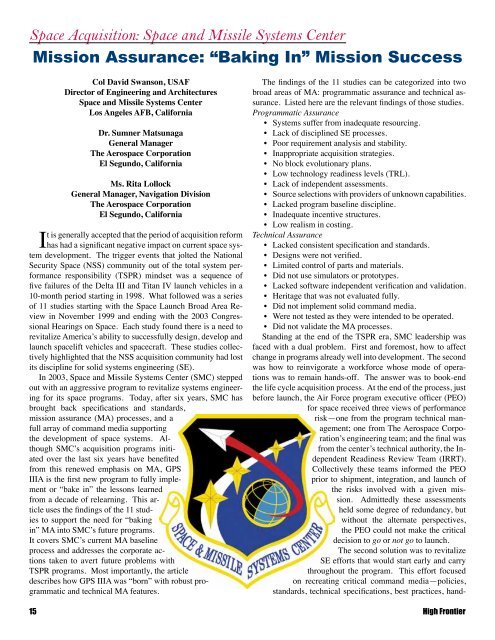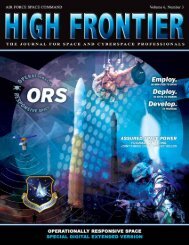Space Acquisition - Air Force Space Command
Space Acquisition - Air Force Space Command
Space Acquisition - Air Force Space Command
Create successful ePaper yourself
Turn your PDF publications into a flip-book with our unique Google optimized e-Paper software.
<strong>Space</strong> <strong>Acquisition</strong>: <strong>Space</strong> and Missile Systems Center<br />
Mission Assurance: “Baking In” Mission Success<br />
Col David Swanson, USAF<br />
Director of Engineering and Architectures<br />
<strong>Space</strong> and Missile Systems Center<br />
Los Angeles AFB, California<br />
Dr. Sumner Matsunaga<br />
General Manager<br />
The Aerospace Corporation<br />
El Segundo, California<br />
Ms. Rita Lollock<br />
General Manager, Navigation Division<br />
The Aerospace Corporation<br />
El Segundo, California<br />
It is generally accepted that the period of acquisition reform<br />
has had a significant negative impact on current space system<br />
development. The trigger events that jolted the National<br />
Security <strong>Space</strong> (NSS) community out of the total system performance<br />
responsibility (TSPR) mindset was a sequence of<br />
five failures of the Delta III and Titan IV launch vehicles in a<br />
10-month period starting in 1998. What followed was a series<br />
of 11 studies starting with the <strong>Space</strong> Launch Broad Area Review<br />
in November 1999 and ending with the 2003 Congressional<br />
Hearings on <strong>Space</strong>. Each study found there is a need to<br />
revitalize America’s ability to successfully design, develop and<br />
launch spacelift vehicles and spacecraft. These studies collectively<br />
highlighted that the NSS acquisition community had lost<br />
its discipline for solid systems engineering (SE).<br />
In 2003, <strong>Space</strong> and Missile Systems Center (SMC) stepped<br />
out with an aggressive program to revitalize systems engineering<br />
for its space programs. Today, after six years, SMC has<br />
brought back specifications and standards,<br />
mission assurance (MA) processes, and a<br />
full array of command media supporting<br />
the development of space systems. Although<br />
SMC’s acquisition programs initiated<br />
over the last six years have benefited<br />
from this renewed emphasis on MA, GPS<br />
IIIA is the first new program to fully implement<br />
or “bake in” the lessons learned<br />
from a decade of relearning. This article<br />
uses the findings of the 11 studies<br />
to support the need for “baking<br />
in” MA into SMC’s future programs.<br />
It covers SMC’s current MA baseline<br />
process and addresses the corporate actions<br />
taken to avert future problems with<br />
TSPR programs. Most importantly, the article<br />
describes how GPS IIIA was “born” with robust programmatic<br />
and technical MA features.<br />
The findings of the 11 studies can be categorized into two<br />
broad areas of MA: programmatic assurance and technical assurance.<br />
Listed here are the relevant findings of those studies.<br />
Programmatic Assurance<br />
• Systems suffer from inadequate resourcing.<br />
• Lack of disciplined SE processes.<br />
• Poor requirement analysis and stability.<br />
• Inappropriate acquisition strategies.<br />
• No block evolutionary plans.<br />
• Low technology readiness levels (TRL).<br />
• Lack of independent assessments.<br />
• Source selections with providers of unknown capabilities.<br />
• Lacked program baseline discipline.<br />
• Inadequate incentive structures.<br />
• Low realism in costing.<br />
Technical Assurance<br />
• Lacked consistent specification and standards.<br />
• Designs were not verified.<br />
• Limited control of parts and materials.<br />
• Did not use simulators or prototypes.<br />
• Lacked software independent verification and validation.<br />
• Heritage that was not evaluated fully.<br />
• Did not implement solid command media.<br />
• Were not tested as they were intended to be operated.<br />
• Did not validate the MA processes.<br />
Standing at the end of the TSPR era, SMC leadership was<br />
faced with a dual problem. First and foremost, how to affect<br />
change in programs already well into development. The second<br />
was how to reinvigorate a workforce whose mode of operations<br />
was to remain hands-off. The answer was to book-end<br />
the life cycle acquisition process. At the end of the process, just<br />
before launch, the <strong>Air</strong> <strong>Force</strong> program executive officer (PEO)<br />
for space received three views of performance<br />
risk—one from the program technical management;<br />
one from The Aerospace Corporation’s<br />
engineering team; and the final was<br />
from the center’s technical authority, the Independent<br />
Readiness Review Team (IRRT).<br />
Collectively these teams informed the PEO<br />
prior to shipment, integration, and launch of<br />
the risks involved with a given mission.<br />
Admittedly these assessments<br />
held some degree of redundancy, but<br />
without the alternate perspectives,<br />
the PEO could not make the critical<br />
decision to go or not go to launch.<br />
The second solution was to revitalize<br />
SE efforts that would start early and carry<br />
throughout the program. This effort focused<br />
on recreating critical command media—policies,<br />
standards, technical specifications, best practices, hand-<br />
15 High Frontier











